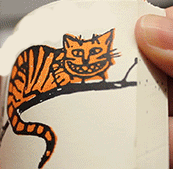|
May 2014
Ever have one of those days, where everything seems to be humming along perfectly, until the very last second? The meat was well marbled, the smoke pale-blue, the temperature on target, but this time, the smoke ring (like the Cheshire Cat's smile), magically disappeared....

To understand all the factors that influence smoke ring formation, you should read through the Smoke Ring Atlas from start to finish. But in brief, myoglobin is turned red by gases in the smoke- mostly nitric oxide. Nitric oxide is produced in the fire from nitrogen in the wood, and oxygen in the air. However, once the meat turns gray (e.g. the myoglobin protein is fractured by heat, typically between 145F and 175F at the meat's surface), the nitric oxide is ineffective at stabilizing the red color. So you want lots of smoke, from wood high in nitrogen, produced in a hot fire that makes lots of nitric oxide (and carbon monoxide), on meat with a high resistance to becoming gray.
A few hints and tips:
- Remove the fat. While smoke ring gases (carbon monoxide and nitric oxide) diffuse through fat almost as quickly as through meat, if the fat is half an inch thick and the ring 1/4" thick, the fat will completely obscure the ring.
- Use fuel with a higher nitrogen content. The amount depends on species and the soil in which it is grown, but in general leguminous trees are highest (e.g. Locust or Mimosa), White Oaks, Dogwood, most fruitwoods and Sorrels are medium, and Red Maple and Sweet Birch are low. Charcoal briquettes are typically high in nitrogen content- higher than most trees. Lump charcoal is usually lower than wood, due to pyrolysis. If you are in an adventurous
mood, try adding peanut shells (2%-3% nitrogen) or dried alfalfa- both are legumes that "fix" nitrogen from the air (though the flavor is a bit different than wood, especially if the fire is smoldering). Or leaves and stems- that's where nature deposits its precious supply of nitrogen.
- Keep the fuel dry- wet fuel drops combustion temperatures, and high temperatures are needed to generate nitric oxide. No wet wood hunks!
- Start off with a vigorous fire, then drop down to slow and low. Even 15 minutes smoking in the fumes from a shimmering red fire produces sufficient NO exposure for a ring.
- Drop the cook temperature- the longer it takes the top 1/4" to heat up, the more time low concentrations of NO, from a modest fire, has time to stabilize the ring. Even dropping from 275F to 2225F during the first hour can make a difference.
- Protect from intense smoke currents. While moving air will bring more flavor to the meat, the bark tends to dry out and the surface heats faster. Turn down the convection fans during the first hour of the cook, if your smoker has this feature.
- Place the wood near the vent's inlet, so it is better oxygenated. Especially important in a gas smoker where just a few hunks of wood are tossed on flames. The higher temperature the fire, the more nitric oxide produced.
- Knock the ashes off the briquettes or coals- the ashes block air, and thus reduce nitric oxide formation.
- Use less salt in the rub- keep it under 1/2 tsp of table salt a pound. Salt LOWERS the meat graying ("denaturing") temperature, so the ring stops forming earlier in the cook.
- Increase the pH of the meat- for example, sprinkle on 1/8 tsp of baking soda/lb of meat just before smoking. The higher the pH, the LONGER myoglobin takes to denature. And thus the larger and deeper red the ring. Helps compensate for acidic meat due to slaughtering and storage conditions. Which may be acidic one day, and nearly basic pH another.
- For the same reason, avoid an acidic rub or marinade early in the smoke. Most mustards, BTW, are vinegar based and quite acidic. Ok to rub on mustard after the first hour or so of smoking.
- Start with cold meat. Cold meat condenses more smoke, and thus more smoke ring chemicals
- Keep the meat's surface moist (but not dripping wet). Moisture allows smoke to adhere, and evaporating moisture produces counter-currents which draw smoke to the surface.

Adapted from Univ of Iowa Miniature book collection
|








